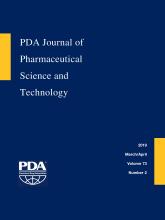Abstract
The regulatory expectations introduced by the U.S. Food and Drug Administration in 1999, ICH Q5C, the revised draft of Annex 1, Eudralex volume 4 for consultation, and the recent update of USP general chapters 1207.1 and 1207.2 regarding container closure integrity (CCI) testing have created a need for further development of testing methods, although there are no universally accepted methods to test and evaluate the CCI of a biopharmaceutical drug product. Each testing method and principle has merits and demerits.
This paper will present a simple approach to be used in method validation of CCI testing based on headspace oxygen analysis for freeze-dried biopharmaceutical drug products in vials, as well as a method for testing and verifying positive control vials. The model is based on Fick's law of diffusion and is empirically corrected to account for Knudsen diffusion in smaller defect sizes. The model considers storage conditions of the vials, allowing for testing of vials stored under anaerobic and near-sealing pressure conditions and different temperature conditions, as well as testing at different time points. Using this approach based on headspace oxygen analysis, the minimum timeframe for leak detection is dependent on the volume of the object tested, but standard vial sizes have shown that leak sizes of 0.2 μm can be detected within hours of vial stoppering with the model developed. CCI testing by headspace oxygen analysis using this approach can be done quickly and non-destructively. This method can prove its effectiveness in demonstration of a protective critical barrier (CCI) for a biopharmaceutical drug product during real-time situations of manufacturing, transportation, registered storage conditions, etc. (life-cycle approach).
LAY ABSTRACT: The recent update of the guideline, USP general chapters 1207.1 and 1207.2, regarding container closure integrity (CCI) testing, has created a need for further development of testing methods. The new methods applied should be deterministic, i.e., describe predefined detection limits and objective quantitative data. Deterministic leak test methods are methods for which the leakage event being detected or measured is based on phenomena that follow a predictable chain of events.
At present, there is no universally accepted method to test and evaluate the CCI of a biopharmaceutical drug product.
This paper will present a simple model-based method based on headspace oxygen analysis for freeze-dried biopharmaceutical drug products in vials, as well as a method for testing and verifying positive control vials. Positive controls are vials with a known defect, e.g., an inserted micropipette.
The model considers storage conditions of the vials, allowing for testing of vials stored under different pressure and temperature conditions, as well as testing at different time points. CCI testing by headspace oxygen analysis using the new approach can be done quickly and without destruction of the vials. This method can prove its effectiveness in demonstration of a protective critical barrier (CCI) for a biopharmaceutical drug product during real situations of manufacturing, transportation, registered storage conditions, etc.
- Container closure integrity testing
- Method development
- Positive controls for container closure integrity studies
- Modeling leak rate for artificial leaks in vials
- Laser-based headspace analysis
- Oxygen
- USP <1207>
- © PDA, Inc. 2019
PDA members receive access to all articles published in the current year and previous volume year. Institutional subscribers received access to all content. Log in below to receive access to this article if you are either of these.
If you are neither or you are a PDA member trying to access an article outside of your membership license, then you must purchase access to this article (below). If you do not have a username or password for JPST, you will be required to create an account prior to purchasing.
Full issue PDFs are for PDA members only.
Note to pda.org users
The PDA and PDA bookstore websites (www.pda.org and www.pda.org/bookstore) are separate websites from the PDA JPST website. When you first join PDA, your initial UserID and Password are sent to HighWirePress to create your PDA JPST account. Subsequent UserrID and Password changes required at the PDA websites will not pass on to PDA JPST and vice versa. If you forget your PDA JPST UserID and/or Password, you can request help to retrieve UserID and reset Password below.






